1998 CADILLAC SEVILLE brake
[x] Cancel search: brakePage 86 of 378
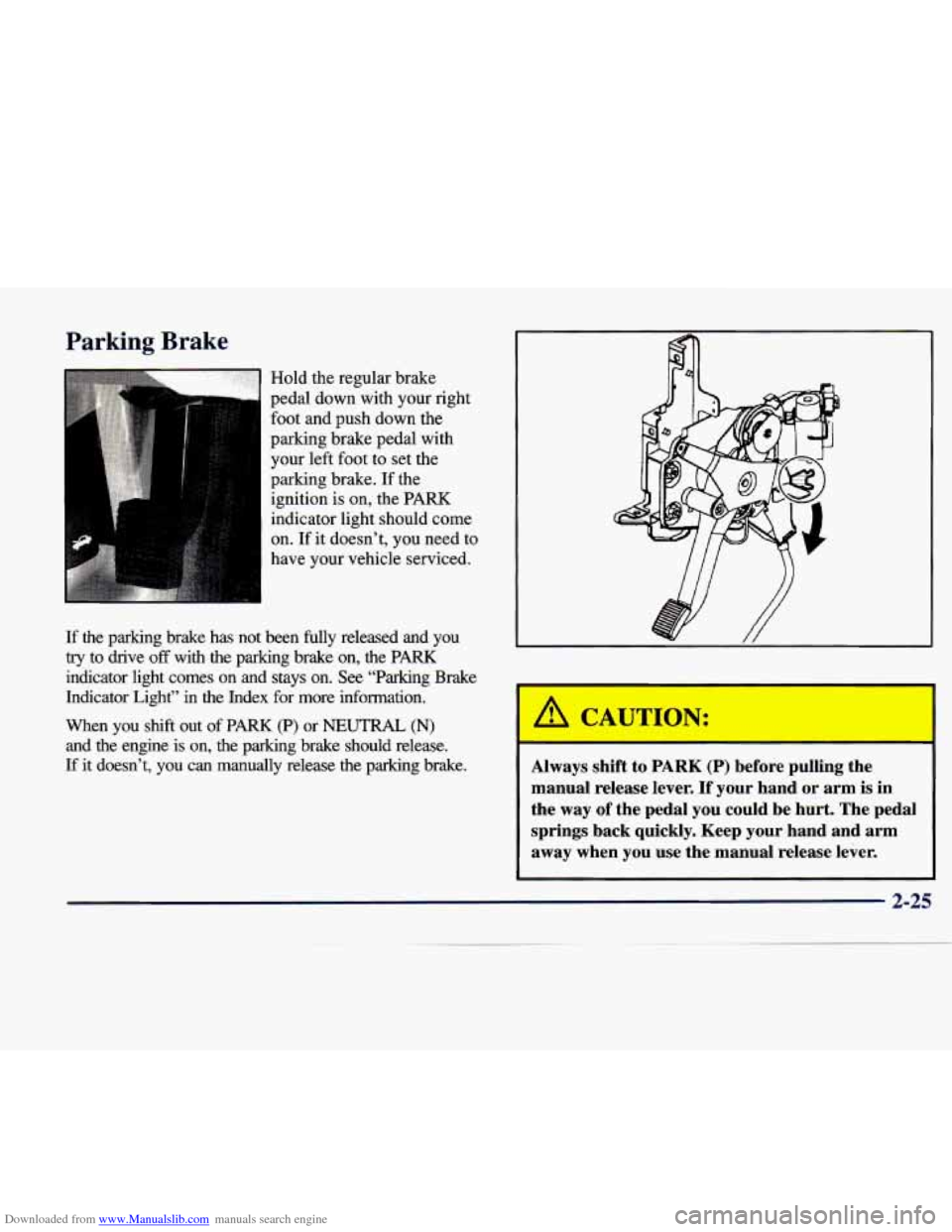
Downloaded from www.Manualslib.com manuals search engine Parking Brake
Hold the regular brake
pedal down with your right
foot and Dush down the
parking drake pedal with
your left foot
to set the
parking brake. If the ignition is on, the PARK
indicator light should come
on.
If it doesn’t, you need to
have your vehicle serviced.
If the parking brake has not been fully released and you
try to drive off with the parking brake on, the PARK
indicator light comes on and stays on. See “Parking Brake
Indicator Light”
in the Index for more information.
When you shift out of
PARK (p) or NEUTRAL (N)
and the engine is on, the parking brake should release.
If it doesn’t,
you can manually release the parking brake.
I I
I I 1
Always shift to PARK (P) before pulling the
manual release lever.
If your hand or arm is in
the way of the pedal
you could be hurt. The pedal
springs back quickly. Keep your hand and arm away when you
use the manual release lever.
2-25
Page 87 of 378

Downloaded from www.Manualslib.com manuals search engine Before releasing the manual parking brake, be sure
to put the vehicle
in PARK (P) and turn the ignition
to
OFF.
Reach under the driver’s side of the instrument panel
and pull down on the manual release lever, which
is
located rearward of the parking brake pedal. A yellow
tab is attached to the manual release lever. If the
parking
brake does not release, you should have your vehicle
towed
to your dealer for service.
NOTICE:
Driving with the parking brake on can cause
your rear brakes
to overheat. You may have to
replace them and you could also damage other
parts of your vehicle.
If
you are towing a trailer and are parking on a hill, see
“Towing a Trailer”
in the Index. This section shows
what to do first to keep the trailer from moving.
Shifting Into PARK (P)
I
’
A CAUTIO,.:
It can be dangerous to get out of your vehicle if
the shift lever
is not fully in PARK (P) with the
parking brake firmly set. Your vehicle can roll. If
you have left the engine running, the vehicle can
move suddenly. You or others could be injured.
To be sure your vehicle won’t move, even when
you’re on fairly level ground, use the steps that
follow.
If you’re pulling a trailer, see “Towing a
Trailer” in the Index.
26
Page 88 of 378
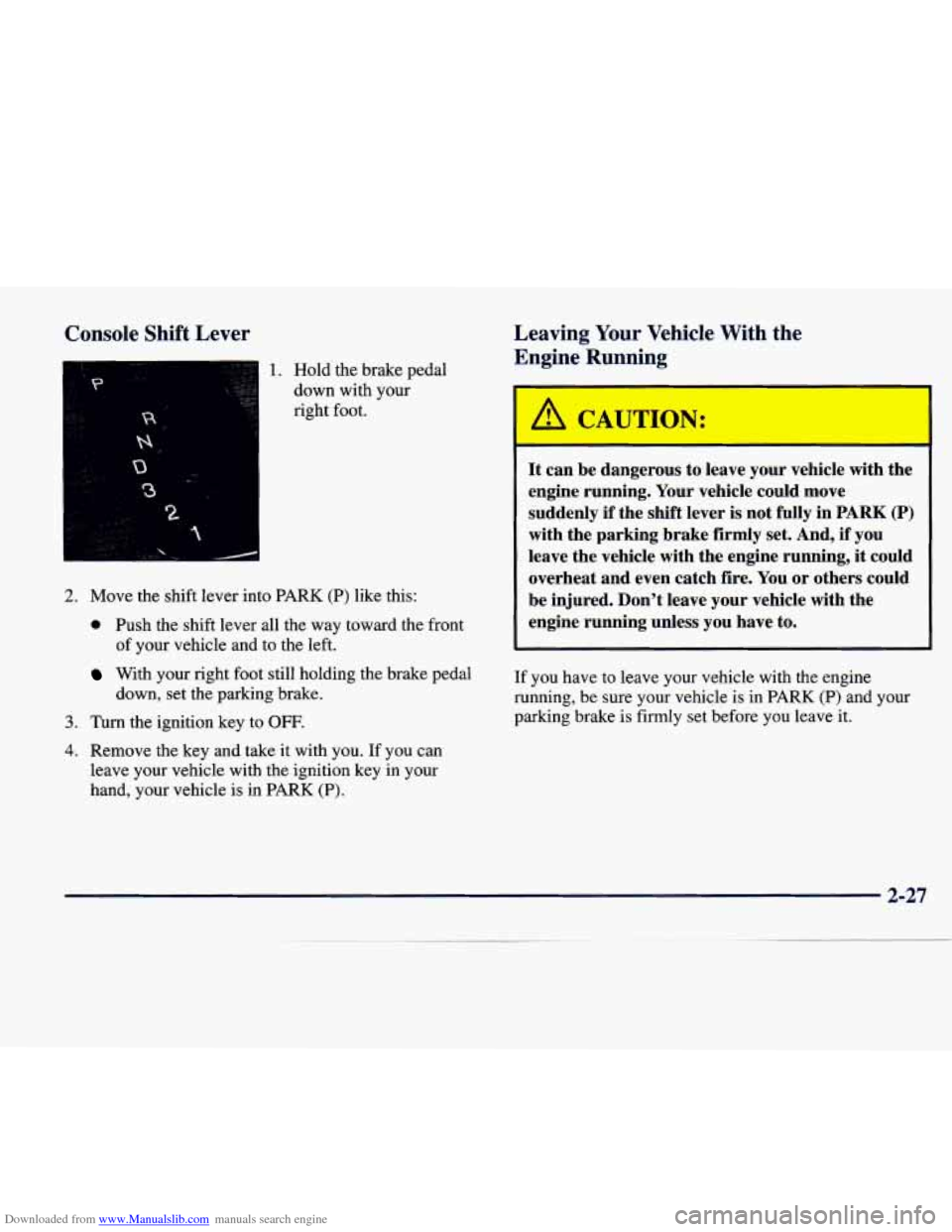
Downloaded from www.Manualslib.com manuals search engine Console Shift Lever
P
a
3
1. Hold the brake pedal
down with your
right foot.
2. Move the shift lever into PARK (P) like this:
0 Push the shift lever all the way toward the front
of your vehicle and to the left.
With your right foot still holding the brake pedal
down, set the parking brake.
3. Turn the ignition key to OFF.
4. Remove the key and take it with you. If you can
leave your vehicle with the ignition key in your
hand, your vehicle is in PARK
(P).
Leaving Your Vehicle With the
Engine Running
I I
U:
It can be dangerous to leave your vehicle with the
engine running. Your vehicle could move
suddenly if the shift lever is not fully in PARK
(P)
with the parking brake firmly set. And, if you
leave the vehicle with the engine running,
it could
overheat and even catch fire. You
or others could
be injured. Don’t leave your vehicle with the
engine running unless you have to.
If you have to leave your vehicle with the engine
running, be sure your vehicle is in
PARK (P) and your
parking brake is firmly set before you leave
it.
I
2-27
Page 89 of 378
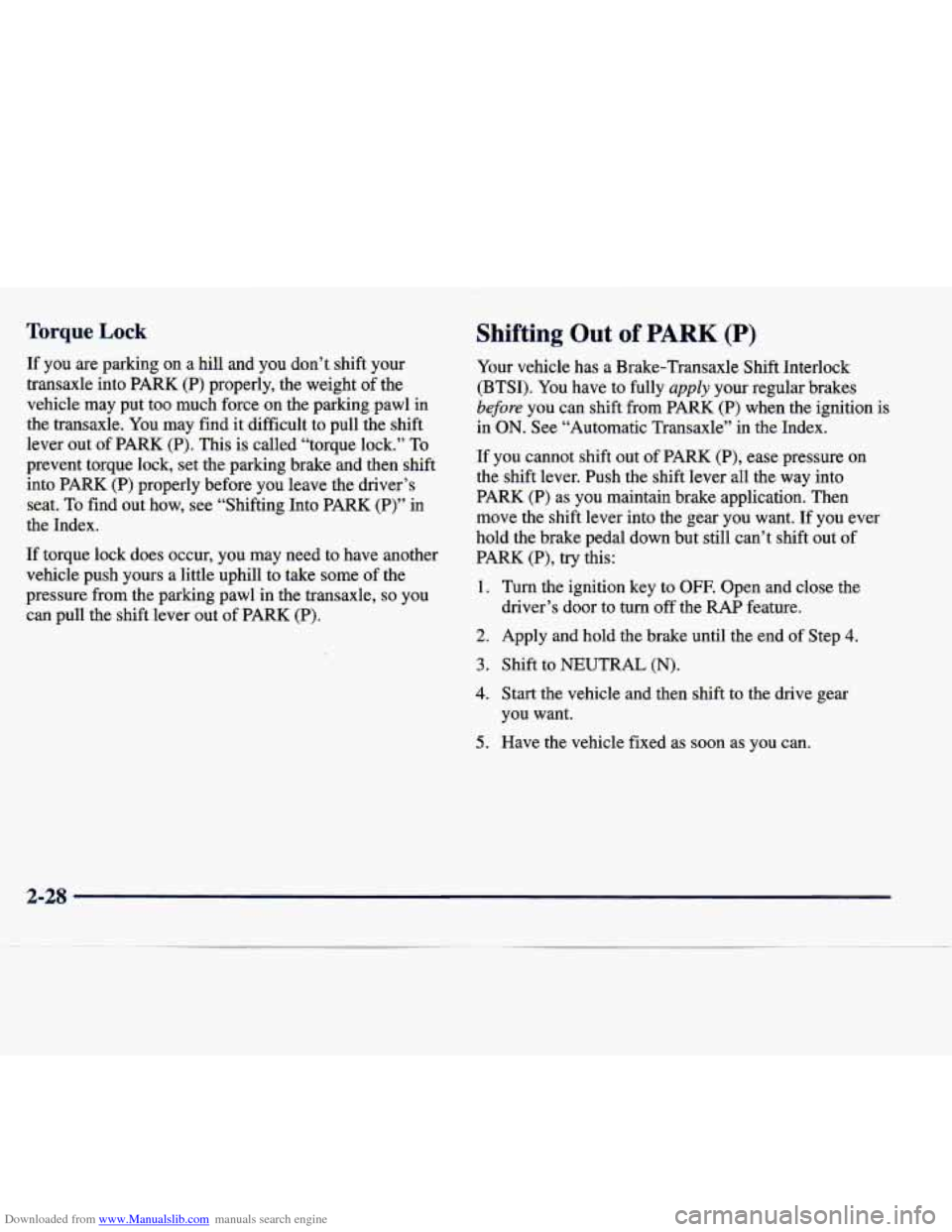
Downloaded from www.Manualslib.com manuals search engine Torque Lock
If you are parking on a hill and you don’t shift your
transaxle into
PARK (P) properly, the weight of the
vehicle may put too much force on the parking pawl in
the transaxle.
You may find it difficult to pull the shift
lever out of
PARK (P). This is called “torque lock.” To
prevent torque lock, set the parking brake and then shift into
PARK (P) properly before you leave the driver’s
seat. To find out how, see “Shifting Into
PARK (P)” in
the Index.
If torque lock does occur, you may need to have another
vehicle push yours a little uphill to take some of the
pressure from the parking pawl in the transaxle,
so you
can pull the shift lever out
of PARK (P).
Shifting Out of PARK (P)
Your vehicle has a Brake-Transaxle Shift Interlock
(BTSI). You have to fully
apply your regular brakes
before you can shift from PARK (P) when the ignition is
in
ON. See “Automatic Transaxle” in the Index.
If you cannot shift out
of PARK (P), ease pressure on
the shift lever. Push the shift lever all the way into
PARK (P) as you maintain brake application. Then
move the shift lever into the gear you want. If you ever
hold
the brake pedal down but still can’t shift out of
PARK (P), try this:
1. Turn the ignition key to OFF. Open and close the
2. Apply and hold the brake until the end of Step 4.
driver’s door to turn off the RAP feature.
3. Shift to NEUTRAL (N).
4. Start the vehicle and then shift to the drive gear
you want.
5. Have the vehicle fixed as soon as you can.
2-28
Page 91 of 378
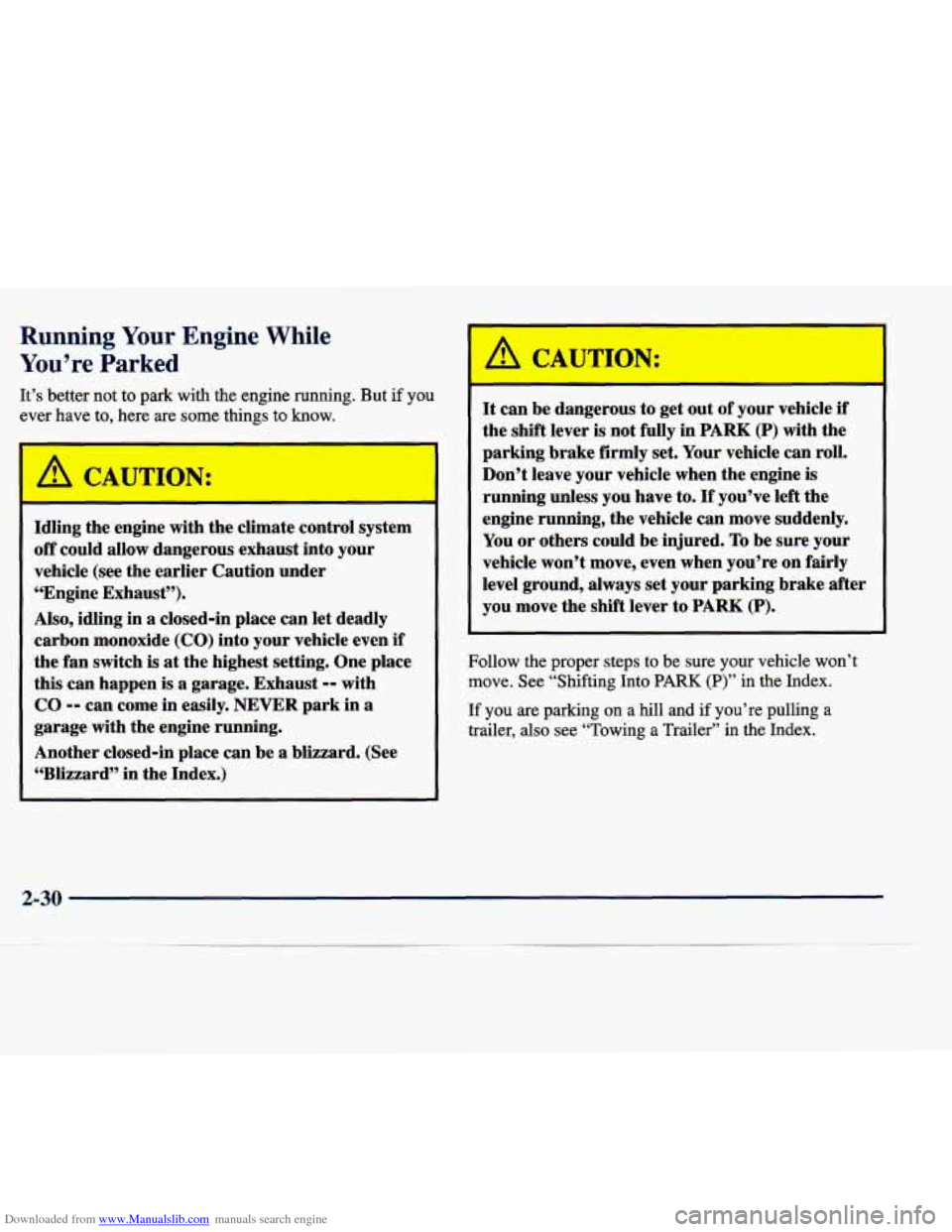
Downloaded from www.Manualslib.com manuals search engine Running Your Engine While
You’re Parked
Idling the engine with the climate control system
off could allow dangerous exhaust into your
vehicle (see the earlier Caution under
“Engine Exhaust”).
Also, idling in a closed-in place can let deadly
carbon monoxide
(CO) into your vehicle even if
the fan switch
is at the highest setting. One place
this can happen
is a garage. Exhaust -- with
CO -- can come in easily. NEVER park in a
garage with the engine running.
Another closed-in place
can be a blizzard. (See
“Blizzard” in the Index.)
It’s better not to park with the engine running. But
if you
ever have to, here are some things to know.
CAUTION:
It can
be dangerous to get out of your vehicle if
the shift lever is not fully in PARK (P) with the
parking brake firmly set. Your vehicle can roll.
Don’t leave your vehicle when the engine is
running unless you have to.
If you’ve left the
engine running, the vehicle can move suddenly.
You or others could be injured. To be sure your
vehicle won’t move, even when you’re on fairly
level ground, always set your parking brake after
you move the shift lever to
PARK (P).
Follow the proper steps to be sure your vehicle won’t
move. See “Shifting Into
PARK (P)” in the Index.
If you are parking on a hill and if you’re pulling
a
trailer, also see “Towing a Trailer” in the Index.
2-30
Page 97 of 378

Downloaded from www.Manualslib.com manuals search engine Windshield Washer Cruise Contr-1
In freezing weather, don’t use your washer until
the windshield is warmed. Otherwise the washer
fluid can
form ice on the windshield, blocking
your vision.
The windshield washer has both a “demand” mode and a “programmed” mode, depending on the amount
of
windshield washer fluid you need.
For programmed mode, press and release the button on
the tip
of the lever. The washer will provide a measured
amount
of fluid to the windshield and the wiper will
either stop or return
to your original wiping speed. For
demand mode, press and hold the button until you have
enough fluid, and the wipers will either stop or return to
your original wiping speed.
CHECK
WASHER FLUID will be displayed on the DIC
when the washer fluid reaches a low level.
The cruise control lever is
located
on the right side of
the steering column.
With cruise control, you can maintain a speed
of
about 25 mph (40 km/h) or more without keeping your
foot on the accelerator. This can help on long trips.
Cruise control does not work at speeds below about
25 mph (40 km/h). When cruise control is on, you will
see
a telltale labeled CRUISE in the instrument cluster.
Cruise control shuts
off when you apply your brakes.
2-36
Page 99 of 378
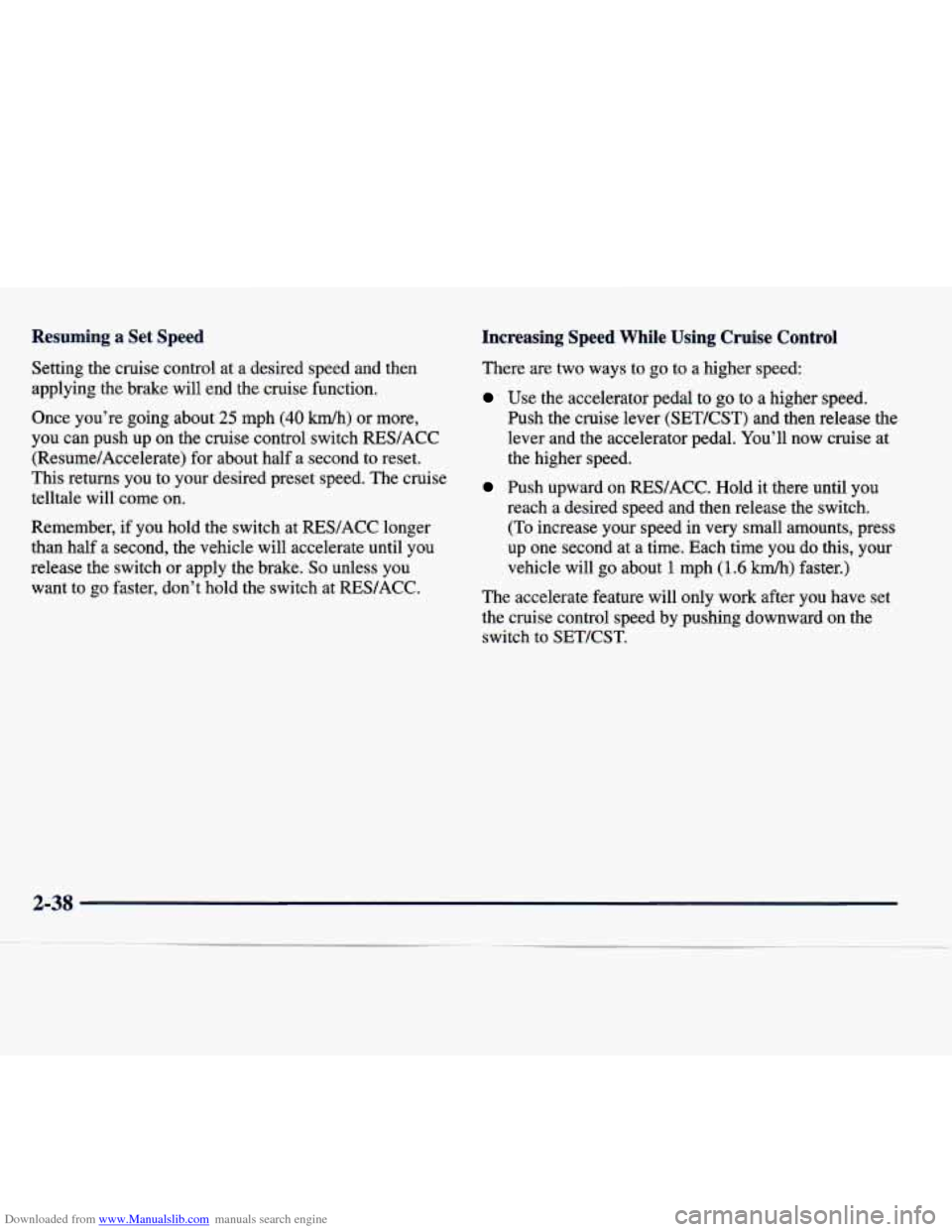
Downloaded from www.Manualslib.com manuals search engine Resuming a Set Speed
Setting the cruise control at a desired speed and then
applying the brake will end the cruise function.
Once you’re going about
25 mph (40 km/h) or more,
you can push up
on the cruise control switch RES/ACC
(Resume/Accelerate) for about half a second to reset.
This returns you to your desired preset speed. The cruise
telltale will come on.
Remember,
if you hold the switch at RES/ACC longer
than half
a second, the vehicle will accelerate until you
release the switch or apply the brake.
So unless you
want to
go faster, don’t hold the switch at RES/ACC.
Increasing Speed While Using Cruise Control
There are two ways to go to a higher speed:
Use the accelerator pedal to go to a higher speed.
Push the cruise lever (SETKST) and then release the
lever and the accelerator pedal. You’ll now cruise at
the higher speed.
Push upward on RES/ACC. Hold it there until you
reach a desired speed and then release the switch.
(To increase your speed in very small amounts, press
up one second at a time. Each time you
do this, your
vehicle will
go about 1 mph (1.6 km/h) faster.)
The accelerate feature will only work after you have set
the cruise control speed by pushing downward on the
switch to SET/CST.
2-38
Page 100 of 378
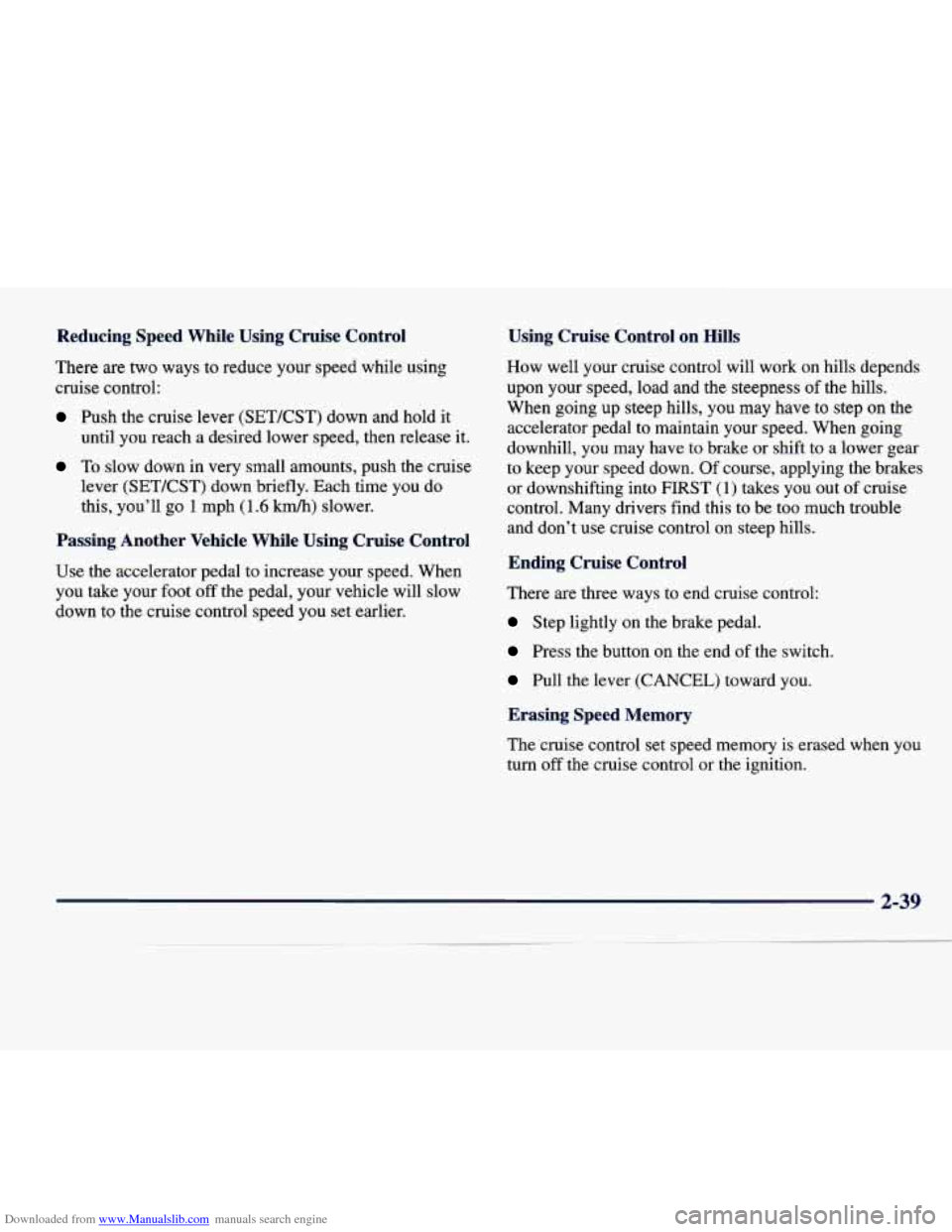
Downloaded from www.Manualslib.com manuals search engine Reducing Speed While Using Cruise Control
There are two ways to reduce your speed while using
cruise control:
Push the cruise lever (SETKST) down and hold it
until you reach a desired lower speed, then release it.
To slow down in very small amounts, push the cruise
lever (SETKST) down briefly. Each time
you do
this, you’ll
go 1 mph (1.6 km/h) slower.
Passing Another Vehicle While Using Cruise Control
Use the accelerator pedal to increase your speed. When
you take your foot
off the pedal, your vehicle will slow
down to the cruise control speed you set earlier.
Using Cruise Control on Hills
How well your cruise control will work on hills depends
upon your speed, load and the steepness
of the hills.
When going up steep hills,
you may have to step on the
accelerator pedal to maintain your speed. When going
downhill, you may have
to brake or shift to a lower gear
to keep your speed down. Of course, applying the brakes
or downshifting into FIRST
(1) takes you out of cruise
control. Many drivers find this to be too much trouble and don’t use cruise control on steep hills.
Ending Cruise Control
There are three ways to end cruise control:
Step lightly on the brake pedal.
Press the button on the end of the switch.
Pull the lever (CANCEL) toward you.
Erasing Speed Memory
The cruise control set speed memory is erased when you
turn off the cruise control or the ignition.